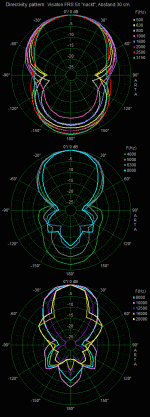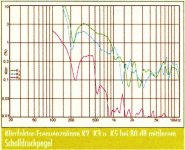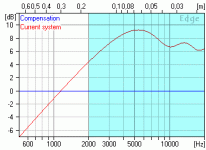Very nice work! The measured performance looks really good, and I'm sure it sounds good also.
But why not reverse one of the woofers to reduce odd order THD products? I know it will look worse... but there is something to gain in sound quality I think. The same goes for adding an other mid, and arrange those two in push-pull as well.
But why not reverse one of the woofers to reduce odd order THD products? I know it will look worse... but there is something to gain in sound quality I think. The same goes for adding an other mid, and arrange those two in push-pull as well.
Congratulations, cuibono!
I think your efforts have produced something great! Thank you for sharing it with the diy community!
I have a question regarding the back wave. How does the phase correction affect the rear radiation. Does it fix the phase irregularity there too or does it make it worse?
Click here: May be of interest.
your new system looks to be a killer. Everything done right.🙂
I have to say that because my latest iteration shares some "features" with yours:
One of the feature, the midrange driver must have a truncated basket ?

My reason is to make the "baffle" as narrow as possible. But primarily I picked that driver (Peerless HDS PPB 4-25/8) based on Xmax and distortion values. And - yes - the "tweeter" is a Visaton FRS5X. One of the last decent 2"-cones not plagued by a 25 mm vented voice coil.One of the feature, the midrange driver must have a truncated basket ?
And - yes - the "tweeter" is a Visaton FRS5X.
So no back radiation for HF at all? That is, dipole up to 'X' kHz ?
Back radiation rolling off above 4 kHz. No competition for the Neo3 of course, but only 12 % of its price in Germany.So no back radiation for HF at all? That is, dipole up to 'X' kHz ?
Attachments
Off topic, but I wonder if you could add a Dayton or similar tweeter in the back to help the back radiation of the Visaton - since both drivers wouldn't interact very much at 4kHz?
I'm not so fond of crossing the Dayton low.
I'm not so fond of crossing the Dayton low.
EDIT: What clips/limits first? i.e. which amp channel, or which driver?
It depends - right now, probably the miniDSP channel for the woofer or mid driver. It has the most EQ boost, so hits the top soonest. But that can be modified so as to not be an issue. I'm not sure what clips first if setup well, it would probably be the mid driver.
Off topic, but I wonder if you could add a Dayton or similar tweeter in the back to help the back radiation of the Visaton - since both drivers wouldn't interact very much at 4kHz?
I'm not so fond of crossing the Dayton low.
Usually back to back tweeters are a mess, worse than a single tweeter. I would try using a backfiring tweeter, say 5kHz and up, and not placed close to the forward tweeter. That might work well...
Back radiation rolling off above 4 kHz. No competition for the Neo3 of course, but only 12 % of its price in Germany.
That definitely looks like an interesting option. I suppose there is some HF roll-off as you stand up? The Pluto's, with their 1" tweete,r have a little roll-off. I find the Neo3 doesn't, which I like a lot. How low can the Visaton be crossed?
I have to ask you guys a question: Does equal front and back radiation through the tweeter range sound natural to you?
Usually back to back tweeters are a mess, worse than a single tweeter. I would try using a backfiring tweeter, say 5kHz and up, and not placed close to the forward tweeter. That might work well...
I too use a MiniDSP and I'd cross the back tweeter at 4-5kHz, yes, probably passively because I need another channel for the woofers.
I'm new to speaker building. I read that a declining power curve towards the high frequencies is often desired in speakers.
So with the back tweeter and the Visaton I could save the small Dayton I have from playing from below 2kHz too. Also the bigger surface area of the 2" should be better at around 2kHz I think.
I have two Daytons (but I haven't built them to play at simultaniously yet) and their back to back config seems to require a notch to tame the polar bulge anyway - as Rudolf kindly showed in his measruements.
The Dayton-Visaton combination might be smoother. 🙂
edit:
Thanks for sharing so many details about your speaker! I don't have the equipment and I'm putting together my own similar dipole.
Last edited:
I believe so, yes. Only very recently have I finished the second speaker and am only starting to get real listening experience beyond sinus sweeps. I will report in a separate thread when things have turned out well.I suppose there is some HF roll-off as you stand up?
I haven't done own distortion measurements yet, but the attached distortion diagram is for the standard FRS5 driver, done at 80 dB. My interpretation is "no lower than 1.5 kHz".How low can the Visaton be crossed?
When I simulate the dimensions of a naked FRS5X in EDGE, the response looks like the second diagram. It reflects my experience, that when crossing at 2 kHz I don't need to push the lower end of the response - just EQ the dipole peak itself. There is added EQ to straighten the response above 8 kHz.
Attachments
I have to ask you guys a question: Does equal front and back radiation through the tweeter range sound natural to you?
If done right, yes. But you should not try it with a separate tweeter on either side of the baffle. That will easily result in the infamous Klingon battleship polar response. Perhaps the smoothness of the polar pattern is more important than the balance between front and back.
I asked because I tried the Neo8s and it felt like there was too much sound radiating to the back... just did not seem natural. Sometimes, it is good take a step back and understand whether what we are trying to do is actually a better solution.
I've never noticed a problem with the neo 8's. I guess it depends on distance to front wall, baffle width, etc., to compare apples to apples. I'm currently running 2 per side, with a medium narrow baffle six feet into the room.
Somehow I missed this topic! Great work, cuibono!
Do you also have some measurements of the response at the rear? I've recently helped a friend design a similar speaker and we focused a lot on making the rear-response an exact copy of the response at the front. Does it make for an audible improvement? I don't know. But it's a great engineering challenge!
Maybe you could send Siegfried Linkwitz an email with details about your 'final' system: Constant directivity loudspeaker designs
Do you also have some measurements of the response at the rear? I've recently helped a friend design a similar speaker and we focused a lot on making the rear-response an exact copy of the response at the front. Does it make for an audible improvement? I don't know. But it's a great engineering challenge!
Maybe you could send Siegfried Linkwitz an email with details about your 'final' system: Constant directivity loudspeaker designs
Outstanding work, cuibono.
I think there is a free iPhone app that does SPL.I wish I had a SPL meter
Is there any way you can meet up with someone who has a pair of Geddes speakers, like the Abbey or Summa? I definitely want to see how these match up.
Isn't that like asking someone to take a ride on a camel and an Iceland pony - afterwards reporting to you which was the better ride? 🙄Is there any way you can meet up with someone who has a pair of Geddes speakers, like the Abbey or Summa? I definitely want to see how these match up.
Wow I missed this great thread!!
How did you do phase correction with MiniDSP??
I thought they are IIR?
How did you do phase correction with MiniDSP??
I thought they are IIR?
- Status
- Not open for further replies.
- Home
- Loudspeakers
- Multi-Way
- Fin, a full range phase linear open baffle speaker, with measurements


